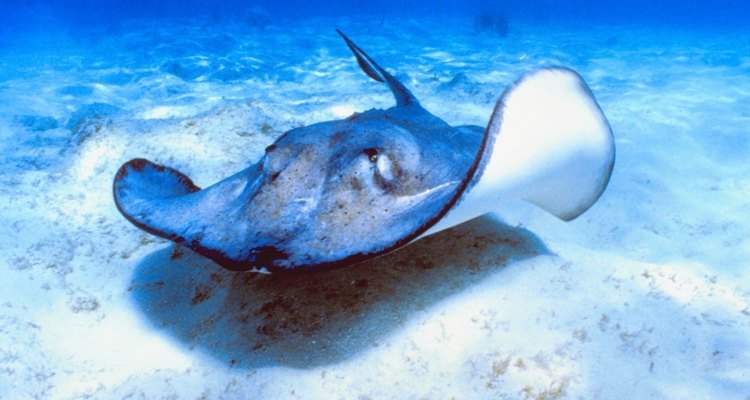
Stingrays are more than just intriguing marine life; they represent a thriving species with fascinating evolutionary traits. From their shape to their hunting techniques, every aspect of a stingray’s anatomy contributes to its success beneath the waves. Let’s dive into how these adaptations make them one of the most fascinating creatures in the ocean.
Flat Body Shape
One of the first things you’ll notice about stingrays is their distinct, flat bodies. This unique shape isn’t just for looks—it’s a clever adaptation that plays a crucial role in their life. Think of it as nature’s way of designing a stealthy predator.
With their flat bodies, stingrays can easily glide just above the ocean floor. This position not only helps them blend in with the sandy substrate but also allows them to stay low while hunting. Camouflaged against the ocean bed, they can surprise unsuspecting prey like fish and crustaceans. It’s like having a secret hideout that makes hunting much easier!
Moreover, their body shape helps them in swimming, too. Unlike other fish that rely on their fins and tails, stingrays use their large pectoral fins to propel themselves smoothly through the water. This gliding motion conserves energy, allowing them to travel long distances without wearing themselves out.
Electroreception
You might be surprised to learn that stingrays have a sixth sense—electroreception. They can detect electrical signals generated by other animals in the water. It’s like having built-in radar that helps keep them fed.
This adaptation is particularly useful when they’re hunting prey buried in the sand. As they swim over the seabed, they can sense the tiny electric fields created by the movements of fish or crustaceans. Once they pinpoint a target, they’re able to strike with remarkable speed and precision.
Think about it: while some predators rely on keen eyesight or sharp hearing, stingrays tap into an entirely different sense that gives them an edge. This unique ability not only boosts their hunting skills but also shows how versatile and smart these creatures are in their environment.
Camouflage and Coloration
Have you ever noticed how some animals can change color or blend into their surroundings? Stingrays are masters of disguise! Their coloration often mirrors the sandy ocean floor, making it hard for predators and prey alike to spot them.
This natural camouflage protects them from larger predators, like sharks, while also helping them sneak up on their prey. When they lie still, they can become almost invisible, showing just how clever and adaptive they are. It’s nature’s version of an invisibility cloak!
Different species of stingrays have varying color patterns, depending on their habitat. Some may be mottled or speckled, while others appear more uniform. These differences help them fit in with their specific environments, whether in shallow coastal waters or deeper ocean locations.
Flexible Spine and Mobility
Stingrays have a flexible spine, which is another significant adaptation that aids in their survival. This flexibility allows them to maneuver with impressive dexterity as they navigate through complex underwater environments.
What does this mean for them? Well, it lets them squeeze through tight spaces between rocks or coral reefs, evading predators or approaching prey. When you watch them swim, it’s almost like they’re dancing gracefully through the water. Their ability to twist and turn effortlessly not only helps them escape threats but also enhances their hunting skills.
This mobility is especially crucial when they hunt in sandy environments. As they slide along the sea floor, that flexible spine allows them to dig in and uncover hidden food sources, ensuring they can make the most out of their habitat.
Venomous Tail
One of the most notorious features of stingrays is their venomous tail. It’s not just a sharp weapon; it serves as a major defense mechanism. If threatened by larger predators, stingrays can whip their tails around with speed and precision, delivering a painful sting.
But here’s the thing—this venom isn’t just for show. It can incapacitate potential threats, giving the stingray a chance to escape. It’s a clever evolution that provides an extra layer of protection in their often perilous underwater world.
However, stingrays are generally not aggressive toward humans unless provoked. They’d much rather blend into their surroundings or swim away if they feel threatened. This means they can coexist peacefully with other marine life in their environment.
Feeding Habits and Unique Diet
Stingrays have developed some interesting feeding habits that contribute greatly to their success underwater. Most stingrays are bottom feeders, meaning they hunt primarily along the ocean floor. Their diet typically includes small fish, crustaceans, and mollusks.
When hunting, they use their mouths located on the underside of their bodies to suck in prey. Some species also have specialized teeth that allow them to crush hard-shelled animals, making it easier to enjoy a diverse menu. It’s like having a built-in toolset for dining under the sea!
Additionally, they have a unique way of foraging. They can dig into the sand with their bodies, using their flat shape to disturb the substrate and uncover hidden prey. This behavior showcases not only their adaptability but also their intelligence when it comes to finding food.
Stingrays are a true marvel of evolution, showcasing a range of adaptations that allow them to thrive in the underwater world. From their flat bodies and electroreception abilities to their impressive camouflage and flexible spines, every feature has a purpose. Their venomous tails serve as a defense mechanism, while their unique feeding habits ensure they have plenty to eat.
These adaptations not only help stingrays navigate their surroundings but also highlight the incredible diversity found in marine life. Next time you encounter a stingray, take a moment to appreciate the unique traits that allow it to effortlessly glide through its aquatic environment. Nature truly has a way of equipping creatures with the tools they need to survive and flourish.
